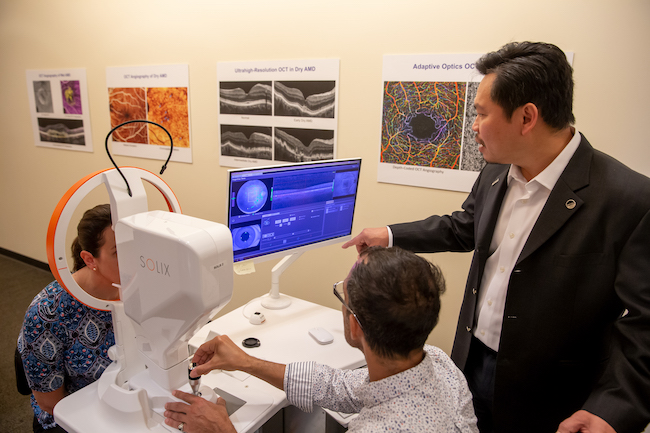OCT (Optical Coherence Tomography)

Optical coherence tomography helps diagnose, treat and manage the eye diseases that are the leading causes of blindness.
OCT was co-invented by David Huang, an OHSU ophthalmologist and biomedical engineer. It’s now a standard test for finding conditions that can cause vision loss, often before patients notice symptoms. OCT is used in more than 30 million eye procedures each year.
What is OCT?
Optical coherence tomography creates highly precise 3D images. It is most commonly used to image the retina in the back of the eye.
OCT scans a beam of light to create 3D images that show the retina’s layers in microscopic detail. OCT can also image the optic nerve, which connects the eye to the brain.
The images reveal problems that might be signs of disease, sometimes years before any symptoms.
OCT of the eye is noninvasive, meaning it does not enter or even touch the eye. Standard OCT uses invisible infrared light, so it is more comfortable than imaging that uses visible light.
Our expertise

The OHSU Casey Eye Institute is a leader in developing noninvasive imaging to help prevent vision loss. Dr. Huang, our associate director and director of research, is known worldwide for his vision research and inventions. He holds 42 patents and has won top prizes in vision research and biomedical engineering.
Dr. Huang continues to develop eye imaging techniques as director of the Center for Ophthalmic Optics and Lasers.
Among them is OCT angiography, a new extension of OCT that:
- Maps the blood vessels in the eye.
- Detects diseases associated with loss of blood flow or growth of abnormal blood vessels.
How OCT is used
OCT is a common eye care test. It is used when you may be at risk for eye disease or when you already have an eye condition.
OCT can help diagnose and manage diseases of the retina, optic nerve and cornea:
Macular degeneration: In age-related macular degeneration, a part of the retina called the macula is damaged, causing loss of central vision.
Diabetic retinopathy: If people with diabetes have excess blood sugar over a long time, it can damage the retina and its blood vessels.
Diabetic macular edema: In people with diabetes, blood vessels in the retina can become leaky. This causes swelling in a part of the retina called the macula.
Glaucoma: Glaucoma damages the optic nerve, which connects the eye to the brain. It commonly causes loss of peripheral vision.
Cornea disease: The cornea is the clear front window of the eye. Damage to the cornea can make vision cloudy or out of focus.
Ocular surface tumors: These are growths on or next to the eye. They can be benign (not cancer) or malignant (cancer).
Eye disease in babies: Babies born before the 37th week of pregnancy or at a very low weight are at risk for a condition called retinopathy of prematurity. This happens when abnormal blood vessels grow in the retina.
What to expect at an OCT scan
An OCT scan takes less than 10 minutes. You will:
- Sit in front of the machine.
- Rest your chin in a plastic holder.
- Look at a target inside the machine. Your eyes will not touch the machine.
- Have an infrared light beam scan each eye. You will not see or feel the beam.
Babies have their eyes scanned with a portable OCT machine. It is held over their eyes while they lie on their backs.
Side effects
Some people may feel dryness or eye fatigue.
OCT may not work on people with:
- Thick cataracts, or cloudy areas in the eye.
- Heavy bleeding inside the eye.
Other uses
OCT and OCT angiography are also used for conditions involving the:
- Heart
- Brain
- Skin
- Digestive system
Make an appointment
Call: 503-494-3000
Vision loss support group
Call: 503-494-1618
Learn about OHSU Casey Eye Institute’s Vision Loss Support Group.